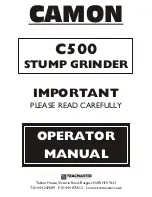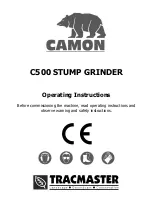
3
uSE OF ExTENSION COrDS
USE ONLY THREE-WIRED EXTENSION CORDS that have 3-pronged plugs and 3-holed outlets that accept the tool’s plug. Repair
or replace damaged or worn cords immediately.
Be sure your extension cord is properly wired and in good condition. Do not use damaged extension cords. Always replace a dam-
aged extension cord.
When using an extension cord, be sure to use one heavy enough to carry the current your product will draw. An undersized cord
will cause a drop in line voltage, resulting in loss of power and overheating. The table below shows the correct size to use accord-
ing to the cord length and the amperage draw of the tool (specified on the nameplate). When in doubt, use the next heavier gauge.
The smaller the gauge number, the heavier the cord. (AWG = American Wire Gauge).
Minimum Gauge for Extension Cords (AWG) (when using 120 volts only)
BEFOrE yOu STArT – PACKAGE CONTENTS
Left work rest ....................................................................... 1
Right work rest ..................................................................... 1
Plain eye shield .................................................................... 1
Magnifying eye shield ........................................................... 1
Eye shield fixing knob ........................................................... 2
Eye shield mounting rod – one left, one right
Eye shield assembly mounting bolt M6x30 ........................... 2
Ampere Rating
Total Length of Cord in Feet (meters)
More Than
Not more Than
25’ (7.6m)
50’ (15m)
100’ (30.4m)
150’ (45.7m)
0
6
18
16
16
14
6
10
18
16
14
12
10
12
16
16
14
12
12
16
14
12 Not Recommended
Use a separate electrical circuit for your tools. This circuit should not be less than a #12 gauge wire, and should be protected with a
15 A time-lag fuse. Before connecting the motor to the power line, ensure the switch is in the OFF position and the electric current
is rated the same as the current stamped on the motor’s nameplate. Running at a lower voltage will damage the motor and is not
covered by warranty.
Eye shield assembly mounting washer D6 ........................... 2
Eye shield assembly mounting locking washer D6 ............... 2
Fix work rest ...................................................................... 2
Adjustable work rest ........................................................... 2
Coolant tray ........................................................................ 1
Spark deflector ................................................................... 2
Spark deflector fixing screw assembly ................................ 2
BEFOrE yOu STArT – ASSEmBLy AND INSTALLATION
Mounting the Grinder to the Workbench
Before attempting to use this grinder, it must be properly mount-
ed to a workbench or grinding stand.
CAUTION! Bench grinders vibrate. Grinder movement during
high-speed rotation may cause injury or damage to the work-
piece or operator. Mount the grinder securely to a sturdy work-
bench or grinding stand.
1. Position the grinder on the workbench.
2. Mark the workbench through the two mounting holes located
in the grinder base.
3. Drill holes in the
workbench at the
marks.
4. Using two long
bolts, washers,
lock-washers and
nuts, as shown
(not supplied), secure
the grinder to
the workbench.
Workbench
Bolt
flat
washer
Flat washer
Hex nut
Eye Shield Installation
Eye shields must be installed before operating the bench grinder.
1. Mount the left and right shield rods to the inside of the wheel
guards using hex bolts.
2. Once shield rods
are firmly in place,
slide the shield bracket
onto the shield rod.
3. Tighten the carriage bolt,
leaving it loose enough to
allow the safety shield to be
raised and lowered easily.
Safety eye
shield
Eye shield
mounting arm
Washer Hex
bolt
Adjustable
knob
Eye shield
NOTE: The eye shield should
move freely when being adjusted,
but stay in place when the
locking knob is tightened.
Summary of Contents for KN 7060
Page 1: ...KN 7060 KN 7070...
Page 8: ...7 EXPLODED VIEW KN 7060 KN 7070...
Page 16: ...www knova com mx...


































